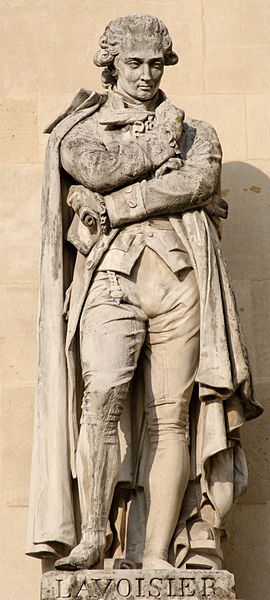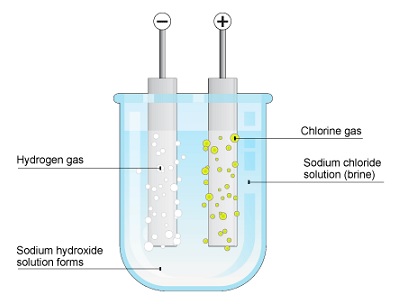"Although different kinds of chemical reactions are thus easily recognized, it has not been found very useful in general to attempt to classify reactions in a rigorous way. Nevertheless, there is one very important class of chemical reactions that deserves special study. These reactions are oxidation-reduction reactions."
Linus Pauling, College Chemistry, 1957
|
History
Of the chemical processes now regarded as redox reactions, combustion was the earliest focus of philosophical and scientific attention. The Greek scientific philosopher Empedocles listed fire as one of the four elements of matter. In more modern times the phlogiston theory enjoyed scientific popularity. This theory was first articulated in 1697 by German chemist G.E. Stahl. As noted earlier, it asserted that matter releases an elementary constituent, phlogiston, during combustion. Thus, the burning of charcoal was interpreted as the loss of phlogiston from carbon to the air. The theory was also applied to processes other than combustion; in the recovery of a metal from its oxide by heating with charcoal, for example, phlogiston was regarded as being transferred from carbon to the oxide. Phlogiston saturation was believed to be responsible for the limited ability of air in a closed container to support combustion. A notable consequence of the phlogiston theory was the notion that an oxide of a metal, such as mercury(II) oxide (HgO), was a chemically simpler substance than the metal itself: the metal could be obtained from the oxide only by the addition of phlogiston. The phlogiston theory, however, could provide no acceptable explanation of the gain in weight when an oxide is formed from a metal. Late in the 18th century the interrelated work of English chemist Joseph Priestley and French chemist Antoine-Laurent Lavoisier led to the overthrow of the phlogiston theory. Lavoisier saw Priestley’s discovery of oxygen in 1774 as the key to the weight gains known to accompany the burning of sulfur and phosphorus and the calcination of metals (oxide formation). In his Traité élémentaire de chimie, he clearly established that combustion consists of a chemical combination between oxygen from the atmosphere and combustible matter (see below Combustion and flame). By the end of the century, his ideas were widely accepted and had been successfully applied to the more complex processes of respiration and photosynthesis. Reactions in which oxygen was consumed were classified as oxidations, while those in which oxygen was lost were termed reductions. |
The similarity of the two processes led to a precursor of the electron-transfer explanation for redox reactions. After the discovery of the electron, the conviction that oxidation and reduction are accomplished through electron loss and gain became firmly entrenched. Thus, early in the 20th century chemists tended to attribute all redox reactions to the transfer of electrons. Later work on chemical bonding, however, demonstrated the incorrectness of that description. An electronegativity scale (listing of elements in descending order of their tendency to attract and hold bonding electrons) provided a firm basis for the oxidation-state assignments on which oxidation-reduction definitions have become based.
As a result, redox reactions — reactions in which there’s a simultaneous transfer of electrons from one chemical species to another — are really composed of two different reactions: oxidation (a loss of electrons) and reduction (a gain of electrons). The electrons that are lost in the oxidation reaction are the same electrons that are gained in the reduction reaction. These two reactions are commonly called half-reactions; the overall reaction is called a redox (reduction/oxidation) reaction.
In general, redox reactions are important because they are the principal sources of energy on this planet, both natural or biological and artificial. Oxidation of molecules by removal of hydrogen or combination with oxygen normally liberates large quantities of energy.
As a result, redox reactions — reactions in which there’s a simultaneous transfer of electrons from one chemical species to another — are really composed of two different reactions: oxidation (a loss of electrons) and reduction (a gain of electrons). The electrons that are lost in the oxidation reaction are the same electrons that are gained in the reduction reaction. These two reactions are commonly called half-reactions; the overall reaction is called a redox (reduction/oxidation) reaction.
In general, redox reactions are important because they are the principal sources of energy on this planet, both natural or biological and artificial. Oxidation of molecules by removal of hydrogen or combination with oxygen normally liberates large quantities of energy.
|
Oxidation
There are three definitions you can use for oxidation, (1) the loss of electrons, (2) the gain of oxygen, and (3) the loss of hydrogen. Loss of electrons One way to define oxidation is with the reaction in which a chemical substance loses electrons in going from reactant to product. For example, when sodium metal reacts with chlorine gas to form sodium chloride (NaCl), the sodium metal loses an electron, which is then gained by chlorine. The following equation shows sodium losing the electron: Na(s) = Na(+) + e(-) When it loses the electron, chemists say that the sodium metal has been oxidized to the sodium cation. (A cation is an ion with a positive charge due to the loss of electrons.) |
Reactions of this type are quite common in electrochemical reactions, reactions that produce or use electricity.
Gain of oxygen
Sometimes, in certain oxidation reactions, it’s obvious that oxygen has been gained in going from reactant to product. Reactions where the gain of oxygen is more obvious than the gain of electrons include combustion reactions (burning) and the rusting of iron. Here are two examples.
Burning of coal: C(s) + O2(g) --> CO2(g)
Rusting of iron: 2 Fe(s) + 3 O2(g) --> 2 Fe2O3(s)
In these cases, chemists say that the carbon and the iron metal have been oxidized to carbon dioxide and rust, respectively.
Loss of hydrogen
In other reactions, oxidation can best be seen as the loss of hydrogen. Methyl alcohol (wood alcohol) can be oxidized to formaldehyde: CH3OH(l) --> CH2O(l) + H2(g)
In going from methanol to formaldehyde, the compound went from having four hydrogen atoms to having two hydrogen atoms.
Gain of oxygen
Sometimes, in certain oxidation reactions, it’s obvious that oxygen has been gained in going from reactant to product. Reactions where the gain of oxygen is more obvious than the gain of electrons include combustion reactions (burning) and the rusting of iron. Here are two examples.
Burning of coal: C(s) + O2(g) --> CO2(g)
Rusting of iron: 2 Fe(s) + 3 O2(g) --> 2 Fe2O3(s)
In these cases, chemists say that the carbon and the iron metal have been oxidized to carbon dioxide and rust, respectively.
Loss of hydrogen
In other reactions, oxidation can best be seen as the loss of hydrogen. Methyl alcohol (wood alcohol) can be oxidized to formaldehyde: CH3OH(l) --> CH2O(l) + H2(g)
In going from methanol to formaldehyde, the compound went from having four hydrogen atoms to having two hydrogen atoms.
Reduction
Like oxidation, there are three definitions you can use to describe reduction, (1) the gain of electrons, (2) the loss of oxygen, and (3) the gain of hydrogen.
Gain of electrons
Reduction is often seen as the gain of electrons. In the process of electroplating silver onto a teapot, for example, the silver cation is reduced to silver metal by the gain of an electron. The following equation shows the silver cation gaining the electron: Ag(+) + e(-) --> Ag
When it gains the electron, chemists say that the silver cation has been reduced to silver metal.
Loss of oxygen
In other reactions, it’s easier to see reduction as the loss of oxygen in going from reactant to product. For example, iron ore (primarily rust) is reduced to iron metal in a blast furnace by a reaction with carbon monoxide: Fe2O3(s) + 3 CO(g) --> 2 Fe(s) + 3 CO2(g)
The iron has lost oxygen, so chemists say that the iron ion has been reduced to iron metal.
Gain of hydrogen
In certain cases, a reduction can also be described as the gain of hydrogen atoms in going from reactant to product. For example, carbon monoxide and hydrogen gas can be reduced to methyl alcohol: CO(g) + 2 H2(g) --> CH3OH(l)
In this reduction process, the CO has gained the hydrogen atoms.
One’s loss is the other’s gain
Neither oxidation nor reduction can take place without the other. When those electrons are lost, something has to gain them.
Consider, for example, the net-ionic equation (the equation showing just the chemical substances that are changed during a reaction) for a reaction with zinc metal and an aqueous copper(II) sulfate solution: Zn(s) + Cu(2+) --> Zn(2+) + Cu
This overall reaction is really composed of two half-reactions, shown below.
Oxidation half-reaction — the loss of electrons: Zn(s) --> Zn(2+) + 2 e(-)
Reduction half-reaction — the gain of electrons: Cu(2-) + 2 e(-) --> Cu(s)
Zinc loses two electrons; the copper(II) cation gains those same two electrons. Zn is being oxidized. But without that copper cation (the oxidizing agent) present, nothing will happen. It’s a necessary agent for the oxidation process to proceed. The oxidizing agent accepts the electrons from the chemical species that is being oxidized.
The copper(II) cation is reduced as it gains electrons. The species that furnishes the electrons is called the reducing agent. In this case, the reducing agent is zinc metal.
The oxidizing agent is the species that’s being reduced, and the reducing agent is the species that’s being oxidized. Both the oxidizing and reducing agents are on the left (reactant) side of the redox equation.
Like oxidation, there are three definitions you can use to describe reduction, (1) the gain of electrons, (2) the loss of oxygen, and (3) the gain of hydrogen.
Gain of electrons
Reduction is often seen as the gain of electrons. In the process of electroplating silver onto a teapot, for example, the silver cation is reduced to silver metal by the gain of an electron. The following equation shows the silver cation gaining the electron: Ag(+) + e(-) --> Ag
When it gains the electron, chemists say that the silver cation has been reduced to silver metal.
Loss of oxygen
In other reactions, it’s easier to see reduction as the loss of oxygen in going from reactant to product. For example, iron ore (primarily rust) is reduced to iron metal in a blast furnace by a reaction with carbon monoxide: Fe2O3(s) + 3 CO(g) --> 2 Fe(s) + 3 CO2(g)
The iron has lost oxygen, so chemists say that the iron ion has been reduced to iron metal.
Gain of hydrogen
In certain cases, a reduction can also be described as the gain of hydrogen atoms in going from reactant to product. For example, carbon monoxide and hydrogen gas can be reduced to methyl alcohol: CO(g) + 2 H2(g) --> CH3OH(l)
In this reduction process, the CO has gained the hydrogen atoms.
One’s loss is the other’s gain
Neither oxidation nor reduction can take place without the other. When those electrons are lost, something has to gain them.
Consider, for example, the net-ionic equation (the equation showing just the chemical substances that are changed during a reaction) for a reaction with zinc metal and an aqueous copper(II) sulfate solution: Zn(s) + Cu(2+) --> Zn(2+) + Cu
This overall reaction is really composed of two half-reactions, shown below.
Oxidation half-reaction — the loss of electrons: Zn(s) --> Zn(2+) + 2 e(-)
Reduction half-reaction — the gain of electrons: Cu(2-) + 2 e(-) --> Cu(s)
Zinc loses two electrons; the copper(II) cation gains those same two electrons. Zn is being oxidized. But without that copper cation (the oxidizing agent) present, nothing will happen. It’s a necessary agent for the oxidation process to proceed. The oxidizing agent accepts the electrons from the chemical species that is being oxidized.
The copper(II) cation is reduced as it gains electrons. The species that furnishes the electrons is called the reducing agent. In this case, the reducing agent is zinc metal.
The oxidizing agent is the species that’s being reduced, and the reducing agent is the species that’s being oxidized. Both the oxidizing and reducing agents are on the left (reactant) side of the redox equation.
Ponder this
When we talk about the "release" of energy, what are we talking about? What was actually released in the combustion (oxidation) of kerosene for instance?
Are there parallels between chemical reactions with atomic reactions (chain reactions in fission and fusion)? Both release energy, are there any other similarities, parallels, and differences?
Discuss
We had discussed the concept of entropy before, whereby nature will take the least amount of energy to maximise mechanical work. By that definition, which side of the process if more entropic, reduction or oxidation? Justify your answer with examples.
Further readings
Elements of Chemistry, the English translation of 'Traité élémentaire de chimie' by Antoine Lavoisier, by Project Gutenberg.
Redox reactions in metabolism, crossing into biology.













